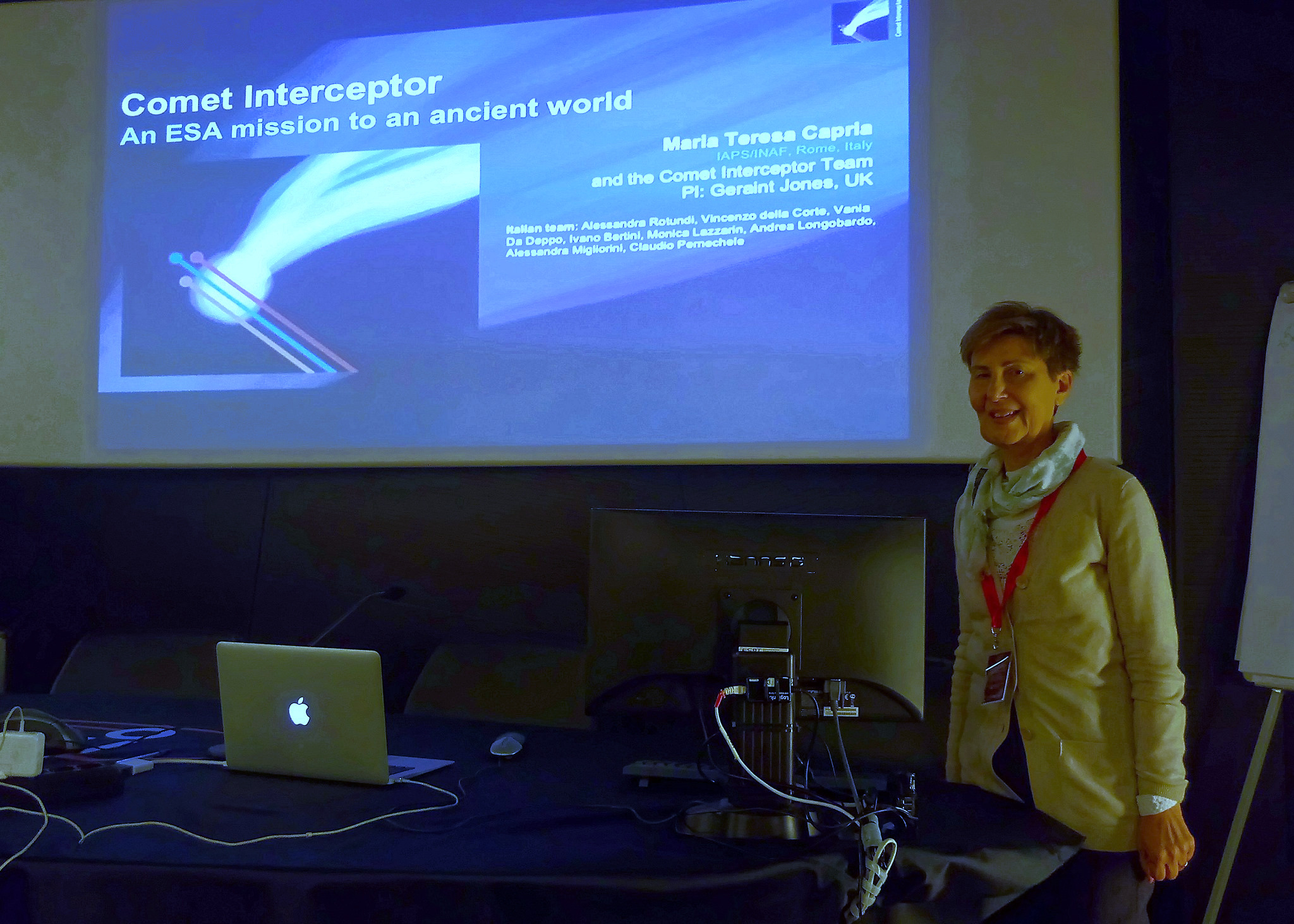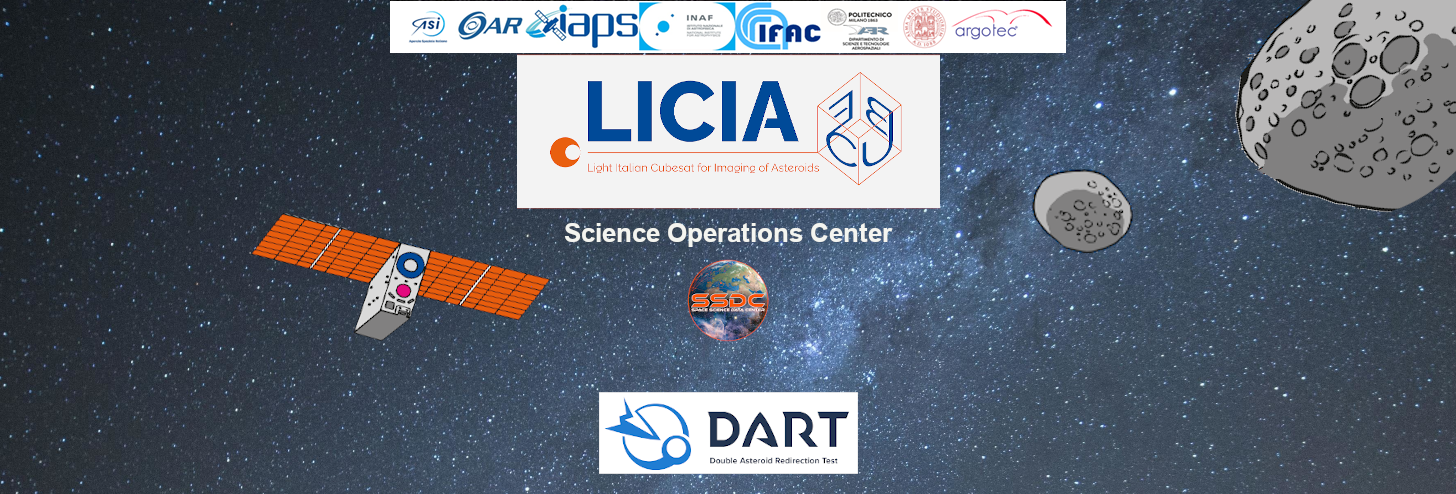
|
| Jul 31, 2024 | eROSITA-DE DR1 Catalogues in the SED Builder We announce that, since July 2024, the eROSITA-DE DR1 Catalogues described in Merloni et al. 2024 (A&A, 682, A34) are available in the SSDC SED Builder. These catalogues (Main, Hard, and Supplementary), including both point-like and extended sources, have been obtained using the data acquired in the first six months of the eROSITA all-sky survey (eRASS1), completed in June 2020. In the SED Builder tool, a selection of bands among those provided by the eROSITA-DE Consortium has been carried out for both the Main and the Supplementary catalogues. Besides the 0.2-2.3 keV band (band 1), five additional bands (P1, ..., P5) have been selected. For the Hard catalogue, all bands (0, 1, 2, and 3) have been included in the SED Builder. The possibility of loading data from the Supplementary catalogue, which includes a higher fraction of spurious sources, is not given by default but needs to be hand-confirmed by the user. |
| Jul 11, 2024 | The MATISSE tool updates towards planetary geology A new paper, with first author Veronica Camplone (SSDC/INAF-OAR/UniPv), has been recently published in the journal Astronomy & Computing. This article details a significant update to the ASI-SSDC scientific web tool dedicated to the analysis of planetary exploration data, MATISSE (Multi-purpose Advanced Tool for Instruments for the Solar System Exploration). MATISSE, launched in 2013, allows for the search and visualization of data, projected even on the three-dimensional shape of the studied objects, using a common web browser without the need for additional software installation. This tool is constantly evolving thanks to new collaborations between SSDC and various research groups, both Italian and international. Currently, MATISSE provides access to data related to Mercury, Venus, Mars, Ceres, Vesta, and Didymos, enabling researchers to conduct comparative analyses and deepen their understanding of the processes characterizing the different explored worlds. The article outlines the recent addition of an advanced functionality to the tool, which allows for data searches based not only on geographical or temporal information but also on higher-level semantic information contained in geological maps. Specifically, the article describes how the ability to search by selecting data on Mercury acquired by the MDIS camera aboard NASA's MESSENGER spacecraft has allowed a focus on craters with central pits using only Matisse, without the need to cross-reference data from various sources. The enhanced functionalities of MATISSE now enable the integration of geological maps and the analysis of specific data based on selected parameters, such as target, mission, instrument, geological units, and area of interest. To demonstrate the effectiveness of this approach, the work focused on the central pit craters of Mercury, particularly in the Hokusai, Victoria, and Derain quadrangles. Using MATISSE for this application allowed for the analysis of these morphologies, confirming a tendency for their location on volcanic terrains. The integrated research approach adopted in this study has proven to be a significant advantage in geological analysis, accelerating the process of data collection and interpretation. In conclusion, this study shows how the continuous evolution of scientific tools dedicated to data management, and management based on FAIR (Findable, Accessible, Interoperable, Reusable) principles, like MATISSE, has the potential to open new perspectives in understanding geological processes on a planetary scale. |
| Nov 06, 2023 | LICIACube data publicly availble at SSDC The data from the ASI LICIACube mission, which performed a flyby of the Didymos-Dimorphos binary asteroid system on 27th September 2022, soon after the first planetary defense test performed by the NASA DART mission, are now publicly available from both the LICIACube SOC, hosted by SSDC, and the SSDC webtool MATISSE. In particular, on the SOC it is be possible to find all the data acquired by the two LICIACube cameras, LEIA and LUKE, in both raw and calibrated form: it is possible to either download the FITS files or the PDS4 granules (FITS observation + XML labels). Also the NAIF SPICE kernels for the mission are available for the download by the SOC, so that accurate mission trajectories, attitudes and pointing can be computed. On the other hand, by means of MATISSE it is possible to search for LUKE images acquired over Didymos interactively projected over the 3D shape model of the target, to be viewed in common web-browsers or to be downloaded and analysed offline. |
| Sep 22, 2022 | SSDC Solar System group at EPSC 2022 This week Edoardo Rognini and Veronica Camplone are at the European Planetary Science Congress in Granada, Spain, with the work "Mercury exploration with MATISSE tool". The combination of a thermophysical model and the capability of selecting data basing upon geological maps, makes MATISSE a very powerful tool for the study of the first planet of the solar system. A capability that would become crucial with the ESA-JAXA BepiColombo mission approximating its scientific phase. |
| Jun 06, 2022 | Paper about SSDC activities for LICIACube published A paper describing the role of SSDC in the LICIACube mission has been recently published on the Planetary Science Journal. Led by Angelo Zinzi, coordinator of Solar System Exploration activities in SSDC, the paper focuses on the preparation of the mission Science Operations Center (SOC), hosted and managed by SSDC. The LICIACube SOC is in charge of processing and archiving the data. Raw images will be calibrated using algorithms developed by INAF. Both raw and calibrated images will be archived following the PDS4 standard, so that, after the proprietary period lasting 9 months from the DART impact on Dimorphos, they can be publicly released straightaway. The paper also describes how the SSDC MATISSE webtool is being adapted to fully exploit LICIACube images, main changes including new geological functionalities and a new thermophysical model, best suited for small, rubble-pile asteroids. |
| Apr 19, 2022 | SSDC in memory of Maria Teresa Capria On Friday, April 15th Maria Teresa Capria, INAF-IAPS Senior Researcher and SSDC Senior Scientist, passed away, after a long period of illness. She has been a renowned expert of thermophysical modeling of planetary bodies also dedicating huge efforts in the definition and application of best practices for data maintenance and curation for planetary exploration missions. Thanks to her role as SSDC Senior Scientist she was one of the founders of the present day organization of the Center for what regards Solar System Exploration, pushing for the development of a tool able to provide users data fusion capabilities and FAIR principles compliance. That tool is now MATISSE and its complete development and diffusion inside the scientific community of interest is also due to its exploitation for VIRTIS-Rosetta and VIR-Dawn datasets, hardly possible without the Maria Teresa will. It is worthy remembering her vision as the major contribution in creating a robust Solar System Exploration research able to develope and maintain her brilliant idea of a multi-disciplinary, open data driven, Planetary Exploration branch in SSDC.
|
| Mar 09, 2022 | Mercury NASA MESSENGER's images on MATISSE Last week an update on the MATISSE webtool, made it possible to search and retrieve calibrated images from the NASA MESSENGER MDIS-NAC camera using the NASA ODE REST protocol. This is a crucial addition, taken into account the thermophysical model already available for Mercury and the work on the geological units planned to be released in the next months. All these new functionalities could be of major interest for the study of Mercury, in preparation for the ESA-JAXA BepiColombo mission, presently on its way to starting orbiting the planet in 2025, making MATISSE a useful tool for data exploitation. |
| Jan 31, 2022 | SSDC MATISSE at the Mercury Exploration Assessment Group Annual Meeting 2022 Helding in virtual form from 1st to 3rd February 2022, this year's Mercury Exploration Assessment Group (MExAG) Annual Meeting will view the participation of the SSDC Solar System Group presenting the current state and planned evolutions of the scientific webtool MATISSE related to Mercury exploration. The agenda of the meeting includes an overview of NASA programs, ongoing science of the innermost planet, updates on ongoing concepts for future spacecraft missions, discussion of the MExAG Goals Document for the future of Mercury science and exploration. For SSDC Angelo Zinzi will present a poster in which the focus of SSDC to the exploration of Mercury will be highlighted as up to now a thermophysical model is available through MATISSE, whereas the group is working to add observations (from NASA's MESSENGER MDIS-NAC) and semantic information (geological maps). The SSDC interest in Mercury exploration is also demonstrated by the recent publication of a work by Edoardo Rognini focused on the effects of its surface temperatures on the exosphere composition. |
| Jan 27, 2022 | SSDC contribution to the 1st ASI Workshop on Astrobiology now available online The proceedings of the 1st Italian Space Agency Workshop on Astrobiology, held in virtual form from 27th to 29th October 2020, have been now published on the "Memorie della Società Astronomica Italiana" journal. The full list of contributions in PDF format are available for the download. SSDC participated to this workshop by presenting its tool ExoplAn3T, dedicated to exoplanetary systems. In particular the possible applications of this tool to the astrobiology field has been then described by Angelo Zinzi and colleagues. Full details on this work can be found here. |
| Nov 24, 2021 | LICIACube begins its cruise to Dimorphos. The SSDC role in the mission The DART planetary defense mission together with its companion cubesat LICIACube has been succesfully launched through a Falcon 9 this morning at the 7:21 Italian time from the Vandenberg base (California). As scheduled, the DART spacecraft was released 56 minutes after launch, and started its cruise phase which will end on October 2022 by impacting Dimorphos, the natural satellite of the Didymos asteroid, slightly deflecting its orbit. LICIACube (Light Italian Cubesat for Imaging of Asteroids) is the first entirely Italian deep space mission, aimed at witnessing the impact and post-impact phase of DART. SSDC is coordinating the LICIACube data management and dissemination, hosting the Science Operations Center (SOC) and developing the automated processing of the raw data received from the Argotec Mission Control Center (MCC). The data format has been defined in collaboration with Johns Hopkins University Applied Physics Laboratory (JHUAPL) to be compliant to the PDS4 standard, and thus both raw and calibrated data will be made available in this format to the team through the LICIACube SOC website. Further ongoing developments will allow to access these data through the SSDC MATISSE scientific webtool, so to enable advanced functionalities for data analysis and visualization.
|
| Jun 30, 2021 | Asteroid Day: the SSDC contribution to asteroid science In memory of the Tunguska asteroidal event, occurred on 30th June 1908, since 2014 this day is named Asteroid Day. The study of asteroids is raising interest over the years and, over the last period, the attention to the threat that Near Earth Asteroids (NEA) potentially represent for human civilization has become an hot topic. SSDC actively participates to a series of programs expressely dedicated to physical and orbital characterization of these objects, in particular by taking part in the H2020 NEOROCKS project, the LICIACube mission and in the future constitution of a long lasting ASI-SSDC NEO Physical Properties Data Center. NEOROCKS NEOROCKS is an H2020 funded project aimed at improving our knowledge of the physical characteristics of the NEO population, in which SSDC is contributing by allowing for a better exploitation of data coming from different sources, using standard protocols to build a database that will be publicly accessible through a web portal with advanced functionalities. This novel application will allow to easily crossmatch different datasets in order to better identify potential hazardous objects and to adequately plan follow-up observations. More info at this link [VIDEO]: https://www.youtube.com/watch?v=DNGbCUAXu0E LICIACube LICIACube is an Italian mission targeting the Didymos-Dimorphos asteroid system to be launched in the fall 2021, that will be carried on by the NASA DART spacecraft for 10 months and will collect images of the effects produced by the DART impact over the Dimorphos surface. LICIACube is equipped with two different cameras, a panchromatic one named LEIA and a RGB one named LUKE, that will allow to perform several studies related to the surface characteristics, the plume generated by the impact and the computation of the shape model for Dimorphos. SSDC is involved in the LICIACube mission for data exploitation and preservation, and it will host the Scientific Operations Center which will organize, calibrate, and distribute the data to partner organizations (e.g. NASA) and to the scientific community through the MATISSE SSDC tool. Link to the LICIACube SOC: https://www.ssdc.asi.it/liciacube/ |
| Sep 17, 2019 | Planetary Geological Mapping project with SSDC participation published on GeoMedia A first outline about the geological mapping project led by the Geological Survey of Italy, ISPRA, and with the participation of SSDC-ASI has been published on the May/June 2019 issue of GeoMedia. The main goal of the project is to apply the same cartographic standard rules used in the Italian Geological Mapping Project (CARG Project) to the realization of geological and geomorphological maps of other planets. In the published report, the Eberswalde crater on Mars has been used as prototype area for its great variability of forms of erosion and demolition and the conspicuous literature. The project presented here is included into the H2020-PLANMAP pilot project, to which SSDC is contributing through the MATISSE webtool (and in particular its brand-new version MATISSE 2.0, currently under development and testing). This tool would indeed result to be fundamental for searching and exploring geological maps produced by PLANMAP converting the areas of interest in different formats, from those typical of the classical 2D GIS applications up to those suited for state-of-the-art 3D Virtual Reality environments. |
| Jul 20, 2019 | The Moon and SSDC: examples from MATISSE Moon Mapping project and Fermi LAT July 20, 2019 marked the 50th anniversary of the first humans landing on the Moon on July 20, 1969 as part of NASA's Apollo 11 lunar mission. Such Apollo 11 mission changed our world and ideas of what is possible by successfully landing humans on the surface of the moon, and bringing them home safely, for the first time in history. During the Apollo program of the 1960s and '70s, NASA sent 9 missions to the Moon, and 6 of them landed astronauts safely on the surface, the only times humans have visited another world. A multinational crew of astronauts, including Luca Parmitano of ESA (European Space Agency) at the second time, is arrived at the International Space Station, with a launch from the Baikonur Cosmodrome in Kazakhstan aboard the Soyuz MS-13 spacecraft, in coincidence with this anniversary. The SSDC activities dedicated to the Moon are mainly those belonging to the "Moon Mapping" research cooperation project, established in 2014 by the Chinese and Italian governments to promote cooperation and exchange between students and scientists from both countries. The Italian Space Agency (ASI) had the responsibility for the coordination of the Italian side of the project and SSDC played a key role in this assignment, in particular during the operational phase, lasted from 2015 to 2017. During this period several universities and research institutes carried on joint activities using data acquired by instruments onboard the Chinese lunar exploration missions Chang'e 1 and Chang'e 2, with major focus on data pre-processing, structural and elemental mapping of the Moon and interaction with the solar wind. The great part of the data have been analyzed and visualized by means of the SSDC tool MATISSE, that allowed to search and map the data directly of the 3D model of the Moon, apart from converting them to 2D formats of widespread use in the scientific community of interest. The final results of the "Moon Mapping" project will be comprised in a textbook, dedicated to the wide public, whose first draft version has been presented during the "2018 Italy-China Week for the Science, Technology and Innovation" (available here in PDF format). Another scientific space mission supported by SSDC, the Fermi Gamma-ray Space Telescope Large Area Telescope (LAT) has produced a novel image of our Moon. If we observe the gamma-ray sky above 100 MeV photon energy the Moon is brighter than the Sun! This surprising vision of the Moon produced by the Fermi LAT is represented, for example, in the image representing the integrated photon intensity significance and based on data collected by the first seven years of operation, reported in 2016 also by the APOD web site. The Fermi LAT doesn't distinguish details on the lunar surface, but a gamma-ray glow consistent with the Moon's size and position in the sky is clearly found at the center of the false-color map. The brightest pixels correspond to the most significant detections of lunar gamma-rays. High-energy charged particles, i.e. cosmic rays, streaming through the Solar System constantly bombard the lunar surface, unprotected by a magnetic field, generating the gamma-ray glow. Because the cosmic rays come from all sides, the gamma-ray Moon is always full and does not go through phases. An updated analysis based on 11-years data is ongoing. The 2016 scientific paper is here. The corresponding INFN news (in Italian) is here.  |
| Nov 05, 2018 | NASA Dawn mission ends after 11 years NASA Dawn mission, the first one to explore two different objects of the main asteroid belt (Vesta and Ceres), ended few days ago after missing two scheduled communication sessions with NASA's Deep Space Network on Wednesday, Oct. 31, and Thursday, Nov. 1. The mission lasted 11 years and, among its precious scientific results, those regarding the composition of Vesta, that has been confirmed as the parent body of the HED meteorites and the discovery of a large carbonates deposit forming a peculiar bright spot inside the Occator crater of Ceres can be cited. SSDC contributions to Dawn are twofolds: the availability of the VIR imaging spectrometer data through the MATISSE tool, and the participation of Marco Giardino (SSDC ITC Manager) to the mission Dawn Archive Working Group. The VIR-Dawn data available through MATISSE have been also used for educational purposes, an activity now part of the curriculum of the "Introduction to Modern Astro-Plasma Physics" course of the East Windsor Regional School District in Hightstown, NJ (USA). |
| Oct 10, 2018 | SSDC interactive analysis tools among US Students: an american public school pioneer project As part of the collaborative efforts with SSDC, Dr. Franco Paoletti incorporated two remote space data analysis activities in the curriculum of the "Introduction to Modern Astro-Plasma Physics" course, recently approved by the Board of Education of the East Windsor Regional School District in Hightstown, NJ (USA). The two activities will see students analyzing data coming from both Solar System exploration and high-energy observations of the Universe, and will be performed using the SSDC interactive online analysis tools: MATISSE for Solar System observations and AGILE-LV3 for the gamma-ray AGILE satellite data. The activities point to reproduce published scientific results, such as the characterization of dark material on the Vesta asteroid (e.g. Palomba et al., 2014) and the analysis of a couple of exceptional bright flares seen in gamma-rays from monster black holes in distant galaxies (e.g. Astronomer's Telegrams: ATel #9186 and ATel #7631). The final goal is to provide the students with knowledge, skills, and competences required to correctly use tools specifically designed at our data center for professional researchers, and to get a better understanding of the day to day work of an astrophysicist. |
| Jun 11, 2018 | MATISSE v1.5 online with a better 3D online visualization method A new version of MATISSE (https://tools.ssdc.asi.it/matisse.jsp) has been released, with the major update regarding the 3D online visualization method. Thanks to the use of a new javascript (https://kitware.github.io/vtk-js/) it is now possible to directly view online the 3D high-resolution models for the great part of the MATISSE targets, including the comet 67P, Vesta, Ceres and Venus, thus overtaking the limitation for larger objects present with the previous technology used. This version has been labeled v1.5 and comes after the implementation of the SAMP protocol to interoperate with VESPA datasets (v1.3) and the addition of the 1 and 2 micron spectral parameters for VIR-Dawn observations of Vesta (v1.4). |
| June 28, 2016 | ASDC participation to high-school outreach program In mid June 2016, twenty high-school students from Liceo Classico "Aristofane" and Liceo Classico "Giulio Cesare" of Rome, spent one week at the Headquarters of the Italian Space Agency (ASI) to participate to the "Alternanza Scuola-Lavoro" (School and Work synergy) project, according to the new indications of the Italian Ministry for Education, University and Research (MIUR) aimed at giving a real work experience to high-school students. On June 17, 2016, the students used ASDC tools to analyze data coming from both Solar System exploration and Universe observation missions, under the guide of Stefano Ciprini, Dario Gasparrini, Fabrizio Lucarelli, Carlotta Pittori and Angelo Zinzi. After a brief introduction by Ciprini and Pittori on the astrophysical observations of the Universe, and by Zinzi on the exploration of the Solar System, the students were divided into four groups of five persons each. The students chose their preferred field of analysis, so that two groups used planetology ASDC tools and the other two groups used Universe observation ASDC tools. 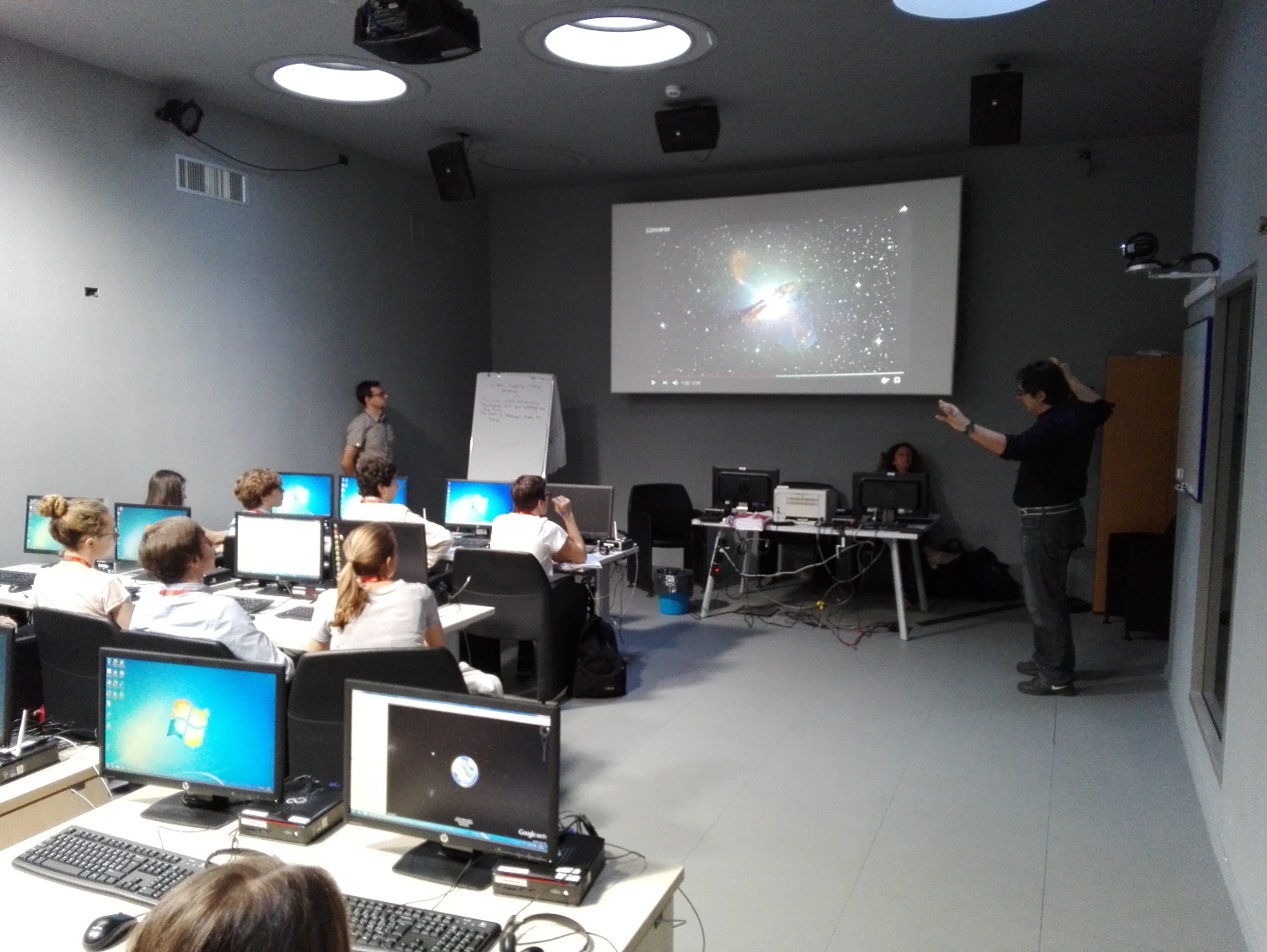 Stefano Ciprini and Carlotta Pittori introducing the subject of Active Galactic Nuclei (AGN) observations. 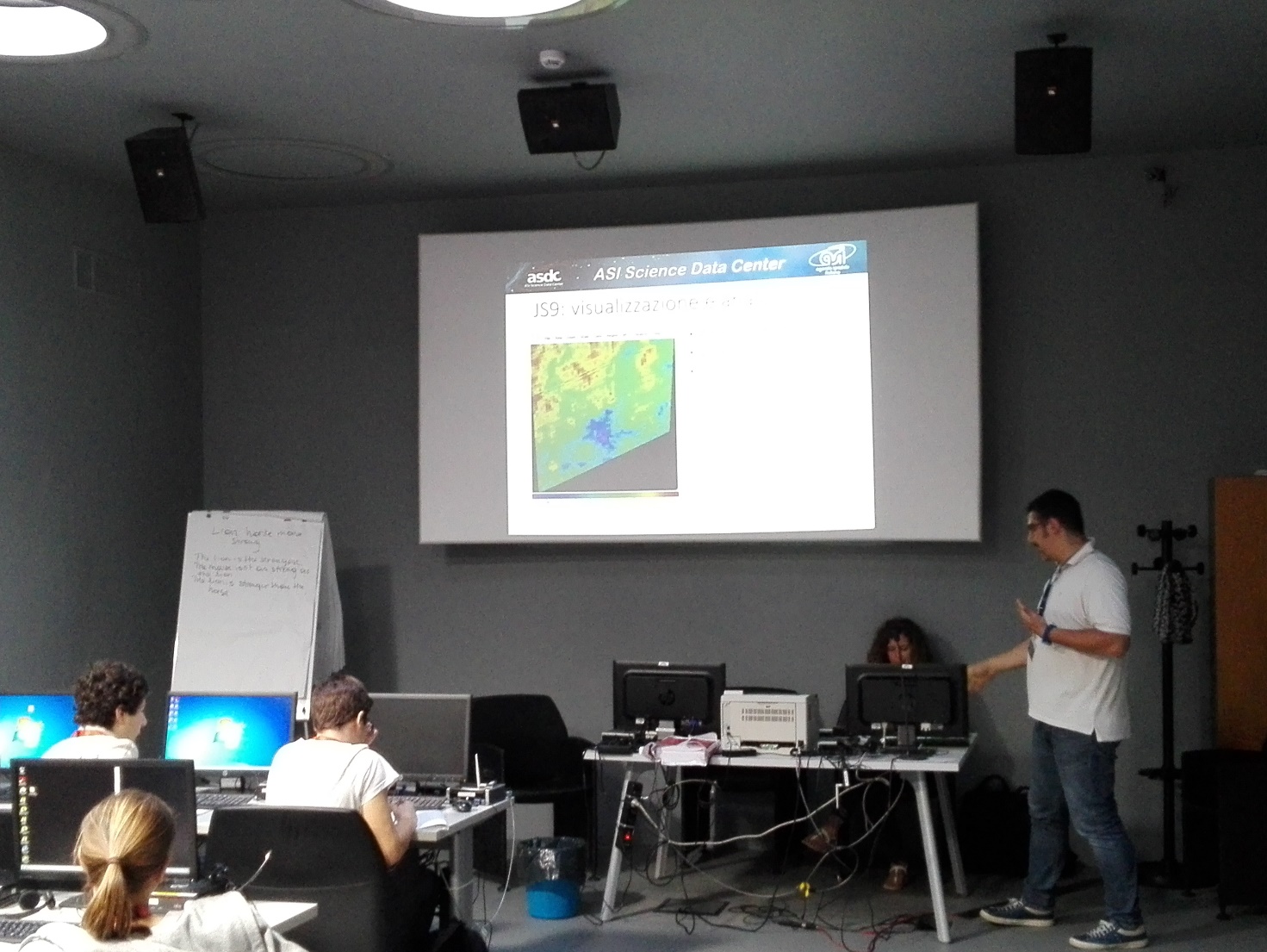 Angelo Zinzi talking about the use of infrared spectra for mineralogic analysis on asteroids. The planetological analysis was carried out by looking at data acquired by VIR spectrometer onboard NASA Dawn mission over the asteroid Vesta. The search for the data was conducted using the ASDC tool MATISSE, whose output (in FITS format) was then passed on to the JS9 tool to evaluate the 1.98 μm band depth, on the basis of the work by Palomba et al. (2015) devoted to the characterization of dark units on Vesta. 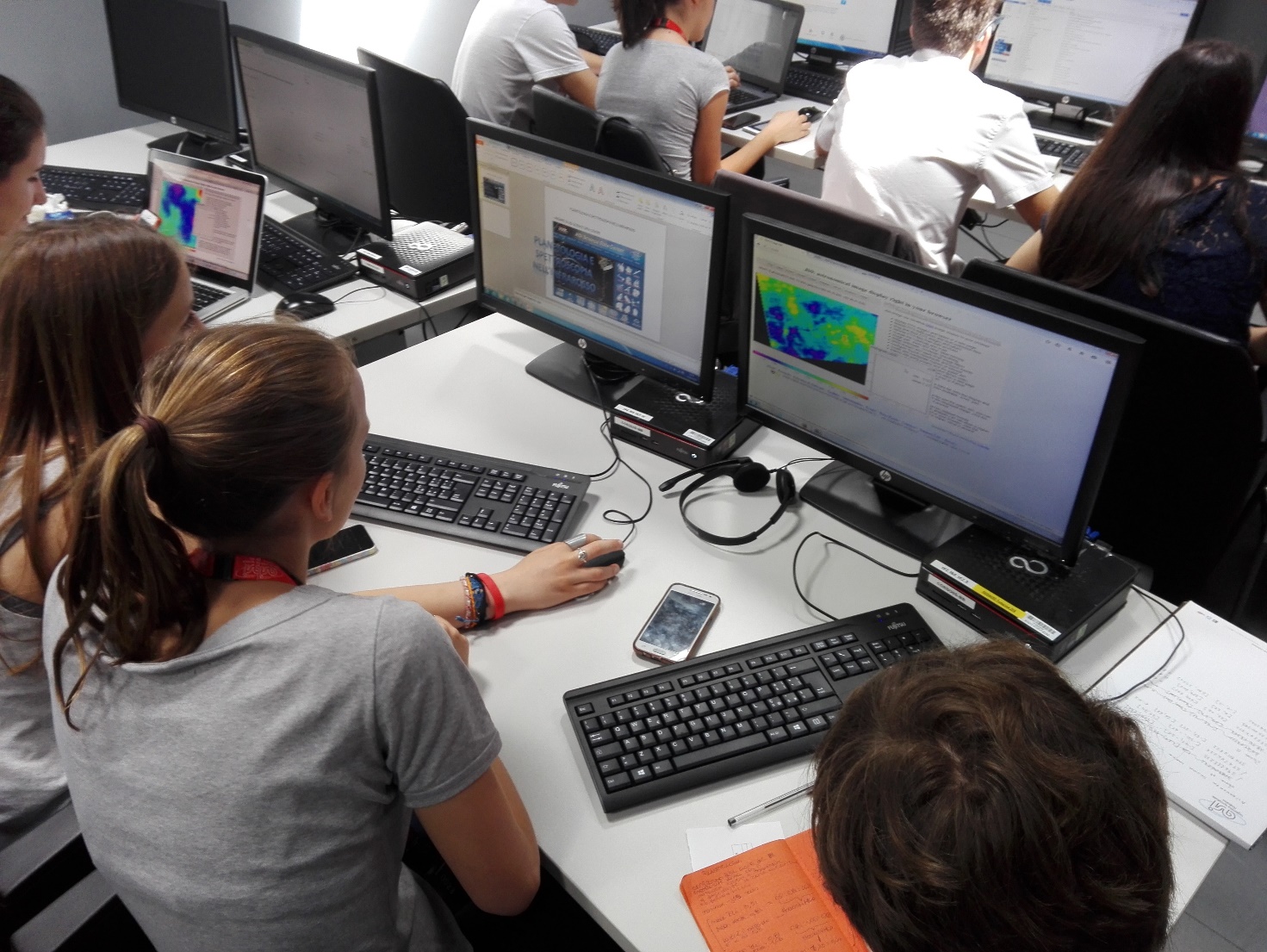 Students working with planetological data The groups of students who chose to use the Universe observation tools from ASDC had to replicate the analysis of a couple of exceptional bright flares seen in gamma-rays from the AGILE satellite from the two AGNs PKS 1510-059 and 3C 279. Starting from the AGILE Astronomer's Telegrams (ATels) #6366 and #7631, announcing the dramatic gamma-ray enhancements, they identified the period of AGN activity and searched the correspondent AGILE data from the MMIA Archive. For this special occasion, we provided the students with access to the AGILE LV3 online analysis tool accessible through the ASDC web pages (the tool will soon become public). They very easily familiarized with the tool and, by means of that, they were able to produce a sky map and a light curve of the two sources, showing the rapid increase in gamma-ray flux observed in correspondence of the period reported in the ATels. At the end of the day, the students compiled a "Daily Log" with all the capabilities acquired during the work. 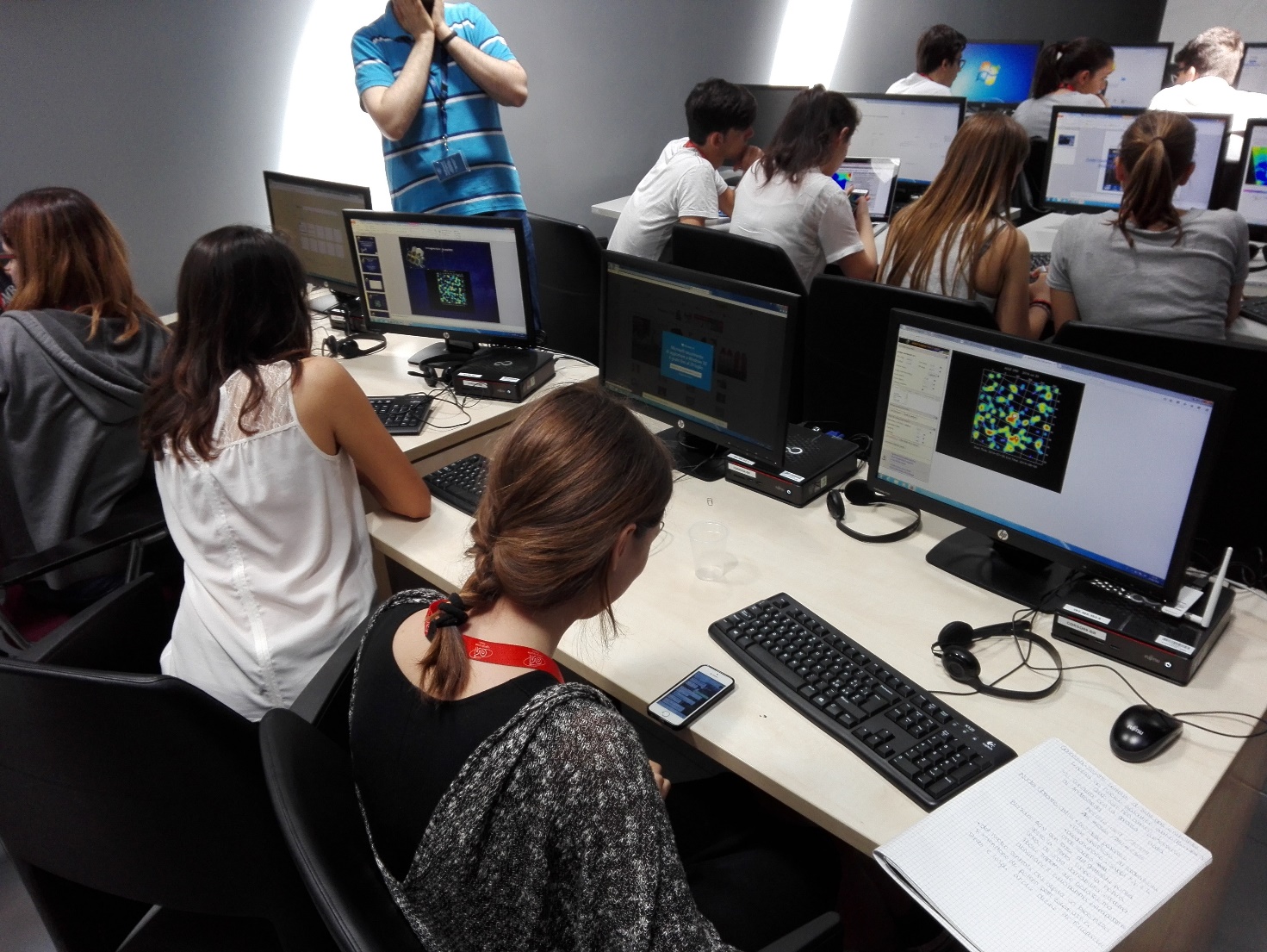 Students analysing AGN data |
| June 28, 2016 | MATISSE on Astrobetter A post about MATISSE, the ASDC web-tool for the exploitation of planetary exploration data, has been recently published on the Astrobetter blog. Accordingly to the goal of Astrobetter to give "tips and tricks for professional astronomers", in the aforementioned post the main characteristics of MATISSE have been described together with an example of usage of the tool. In particular the analysis of the thermal infrared part of the spectrum of asteroid Vesta acquired by VIR instrument aboard NASA Dawn mission has been shown. As these data are publicly available the example can be easily replicated by everyone accessing MATISSE. |
| May 23, 2016 | The 4th Moon Mapping project Workshop On May 10 and 11 2016 the 4th workshop dedicated to the Italian-Chinese project known as "Moon Mapping" took place at the ASI headquarters in Rome. The event started with the joined signature of the Intellectual Property agreement by ASI President R. Battiston and COSE vice-president G. Xie. More than 30 researchers and students from Italy and China involved in the study of the Moon by means of data acquired by instruments onboard the Chinese Chang'e 1 and Chang'e 2 missions participated to the meeting. The main topics of the joint project (i.e., Map of the solar wind ion, Structure map of the Moon, Map of elements distribution and Establishment of 3D digital visualization system) have been actively discussed together with the presentation of external activities related to the exploration of the Moon and of the Solar System in general. During the visit to Italy, the Chinese delegation also visited the INFN National Laboratories in Frascati and the facilities of Thales Alenia Space and ALTEC in Turin. Detailed information about the Moon Mapping project can be found on https://solarsystem.ssdc.asi.it/moonmapping 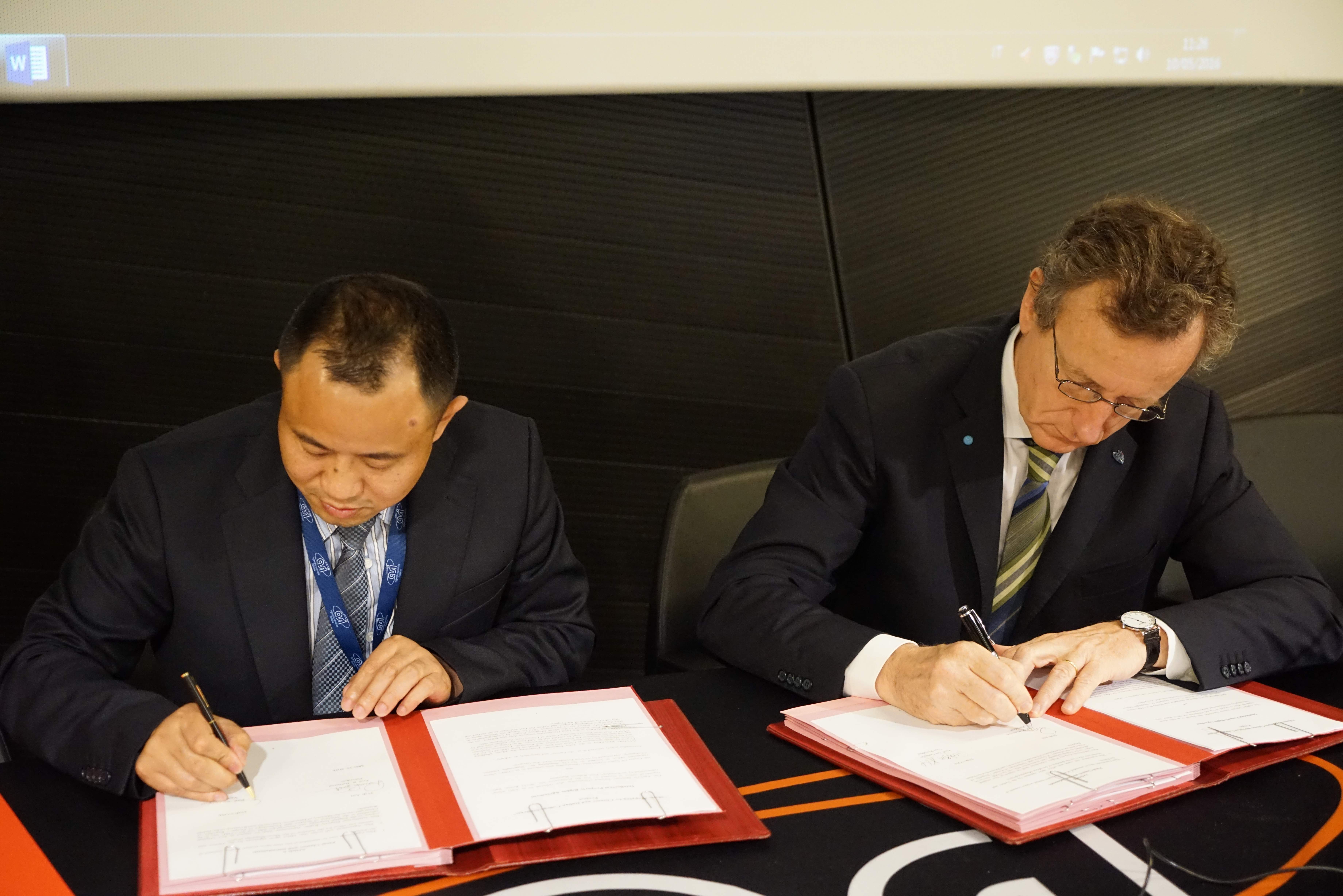 ASI President R. Battiston and COSE vice president G. Xie while signing the Intellectual Property agreement 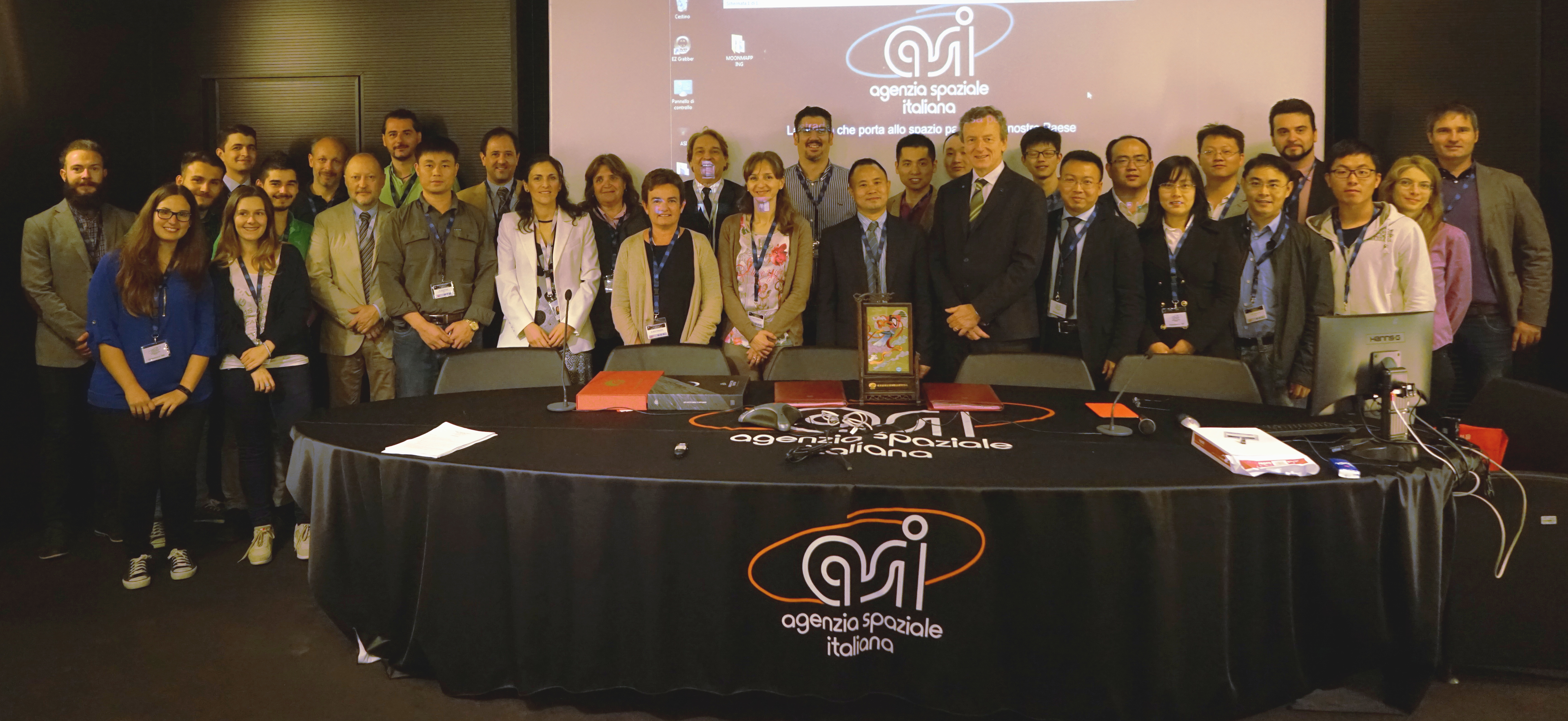 |
| Mar 16, 2016 | MATISSE published on Elsevier's Astronomy and Computing A paper describing both architecture and functionalities of the ASDC webtool MATISSE has been recently published on Astronomy and Computing journal. The PDF of the paper can be downloaded for free until May 4 at http://authors.elsevier.com/a/1Sivt7tDLP025w. Article title: MATISSE: a novel tool to access, visualize and analyze data from planetary exploration missions Full bibliographic details: Astronomy and Computing (2016), pp. 16-28 DOI information: 10.1016/j.ascom.2016.02.006 |
| Mar 03, 2016 | ASDC contributions to the Italian National Congress on Planetary Sciences At the 13th Italian National Congress on Planetary Sciences, held in Bormio from 21st to 26th February 2016, the ASDC Solar System Exploration coordinator Angelo Zinzi illustrated the latest upgrades to the ASDC MATISSE tool and presented the Moon Mapping project, an example of successful cooperation between Italy and China, using the data from the Chang'e-1 and Chang'e-2 satellites. |
| Oct 16, 2015 | MATISSE v1.1 now online with major upgrades A new version of MATISSE (Multi-purpose Advanced Tool for Instruments for the Solar System Exploration) has been released. The most noticeable features introduced with the version 1.1 now online are:
For any question or suggestion feel free to contact angelo.zinzi@asdc.asi.it 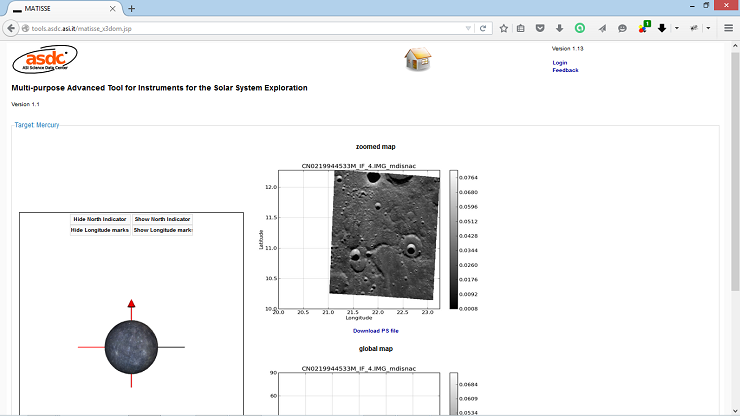 The MATISSE output page, with the 3D view of Mercury and the 2D projected map of data selected 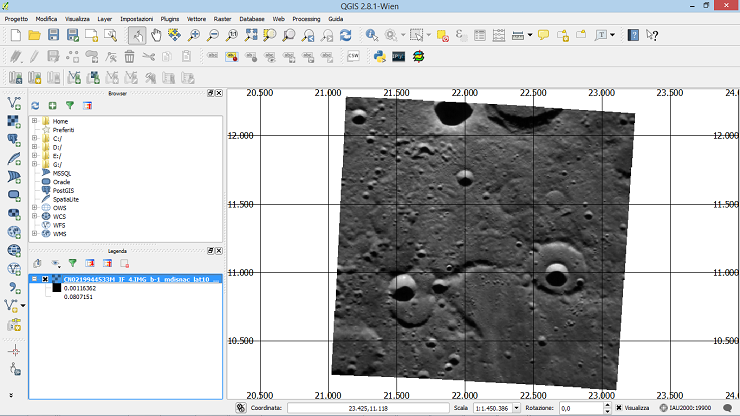 GeoTIFF image from Mercury created with MATISSE and viewed with QGIS |
| Apr 21, 2015 | Lunar data ingested in ASDC's MATISSE tool In the framework of the Chinese-Italian "Moon Mapping" project lunar data acquired by the Chinese mission Chang'E-1 are now accessible through the MATISSE tool at ASDC for the members of the collaboration. The data comprise all 187 quadrangles in which the Moon has been divided for DEM (Digital Elevation Model) and DOM (Digital Ortophoto Map) and the 3 Element Abundance Maps (EAM), at a resolution of 5°x5° available at http://moon.bao.ac.cn/ceweb/datasrv/dmsce1.jsp after registration and login. MATISSE can visualize all the products on a 4 pixel per degree (ppd) model of the Moon and DEM and DOM can be downloaded as Paraview files at a resolution of 60 ppd (corresponding to the DEM one). |
| Feb 06, 2015 | ASDC Solar System coordinator to present Italian Space Agency exhibition about Rosetta on 14 February 2015 On 14 February 2015 at 4:30 pm Angelo Zinzi (ASI Science Data Center - Solar System Exploration) wil present the exhibition "Rosetta cacciatrice di comete" ("Rosetta the comet chaser"), held in Faenza, at the Palazzo delle Esposizioni (Corso Mazzini, 92). The exhibition will be open from 14 February to 1st March with free entrance and is the outcome of the cooperation between the Italian Space Agency and the Casa Museo 'Raffaele Bendandi'. Opening hours: from Tuesday to Sunday, from 9.30 am to 12.30 pm and from 3.30 pm to 6.30 pm (morning only on Thursday and Saturday). For more info go to the Italian Space Agency press release here. |
| Jan 21, 2015 | ASDC Solar System Exploration at the AGU Fall Meeting 2014 Global maps of albedo, VIS/IR slope and organics, computed with the VIRTIS instrument onboard ESA Rosetta mission, have been projected with a prototipal stand-alone Python software developed at ASDC on the 3D shape model of the comet 67P Churyumov-Gerasimenko and shown in the oral presentation by Filacchione et al. at the American Geophysical Union Fall Meeting held in San Francisco on December 2014. The video of the presentation can be watched here. |
| Jan 20, 2015 | MATISSE v1.0 available The new version of the tool can be considered the first stable one, including important features such as the full selection of data based not only upon geographical charateristics, but also on the phase, incidence and emission angles. The visualization has been improved by using an arrow indicating the North, 4 marks indicating longitudes 0°, 90°, 180° and 270° and a grid superiposed over the shape model. Furthermore a Paraview-formatted file for high-resolution analysis is included in the downloadable archive. The tool is available at https://tools.ssdc.asi.it/matisse.jsp. |
| Sep 09, 2014 | MATISSE presented at EPSC 2014 On Thursday 11th September, in the session MTI5 of the EPSC 2014 presentely held in Estoril (Portugal), the new version of MATISSE will be illustrated. The talk will be presented by Angelo Zinzi in room Venus at 2 pm. The abstract of the talk is downloadable at www.epsc2014.eu. |
| Sep 09, 2014 | The MATISSE hands-on tutorial video is online The full video (abouth 90 minutes) of the hands-on tutorial of MATISSE, registered on 3rd June 2014, is now available for streaming and download on https://solarsystem.ssdc.asi.it. Everyone interested to MATISSE is strongly encouraged to view the video in order to better know the tool. |
| Apr 30, 2014 | A new version of the MATISSE tool and the Solar System web pages at ASDC. System Exploration), has been deeply upgraded. A new version (V. 0.6) provides: - searchable database, including observations from the three instruments of the International Rosetta Mission (that recently woken up) with strong Italian participation: the visible camera OSIRIS, the infrared imaging spectrometer VIRTIS-M and the dust analyzer GIADA; - multi-observation by means of which both averages (i.e., mosaics) and ratios between observations can be performed; - user privileges functionalities to enable the use of proprietary data, accessible only to users belonging to specific groups. Thanks to its modular structure the tool is ready to be further upgraded with other types of data and missions (i.e., NASA Dawn to asteroid Vesta and Ceres), without changing the code behind it. To access MATISSE go to https://tools.ssdc.asi.it/matisse.jsp and click "Login": after the user set-up has been completed please send an email to angelo.zinzi@asdc.asi.it to be added to the list of user that can access the tool. In the same email please also specify if you belong to one of the scientific teams, requiring access to proprietary data. |
